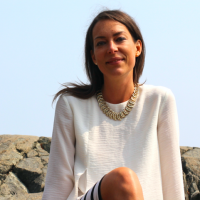One summer night, everything in me broke—each ounce of glue holding together the pieces of my life dissolved.
That night, all I could do was lean back into the brick wall of the street corner I was standing on and slide to the ground amidst rivers of my own tears.
Grief had found me and it was not going to let go. For the next few months it snuck into conversations. It seeped into memories. It permeated landmarks and inhabited all the familiar crevices of my home. It jumped out from behind doors and snuck out of closets I thought I had cleared out years ago.
I was whole-heartedly immersed in the painful loss of someone I had dearly loved.
~
In Buddhism, it is believed that our attachment causes our suffering. My attachment to this now-absent person was causing mine.
I began to perceive some isolating beliefs layered inside this deep pain. When we are in grief, we tend to forget that loss is a universal experience—one we have each intimately known.
The truth is, we are never alone in our suffering, for life is a continual process of letting go for all of us.
There is a countering belief in Buddhist philosophies, too, that while attachment causes suffering, learning to love all sentient beings equally can ease it.
So I began the process of untangling my grief by trying to understand that there were still so many ways I could share and experience love.
I had mistakenly been allowing my grief to act as a shield over my heart, and I needed to let go of this armor.
The traditional grieving process in Tibetan Buddhism lasts 49 days, with ceremonies held every seven of those days for the bereaved and a final one year anniversary celebration to say the last goodbye.
The focus of these ceremonies is not on the sadness of the people who have experienced the loss. The focus is on the individual who left and on our wish for them to have a better rebirth next time around.
With this practice we create compassion out of our grief. We choose to send love instead of sadness to whomever we are missing.
From this perspective, it is through kindness that we transcend grief, for love can be bigger and grander than we had ever imagined, and we can use it to help us heal. We expand our hearts and minds when we choose to send tenderness even to the people and places where there is hurt.
We cannot ever completely avoid loss, but can continually pursue creation.
I was realizing that loving-kindness can be the hallway through which grief leaves.
Holding sweetness in our hearts is easier than holding pain. As we do this, grief becomes an expression of unconditional love. For goodbyes can carry a certain sweetness to them, one in which we allow new compassion to permeate the aching of our heart.
As I began to see my grief not as armor, but as a tool to create more tenderness, I was met by the Buddhist meditation practice called Metta Bhavana (metta in Pali means love or friendliness, and bhavana means to develop or cultivate). I came to understand that the experience of loss is temporary, but that love lasts forever.
So if we are stuck in the hardness of grief we can try this ancient practice to soften us. When we are hit with loss, we can choose to send love instead of sorrow.
Metta Bhavana:
First off, this practice can be done wherever and whenever we need it! Simply begin to focus on the breath and bring your attention to your heart center (we can first send ourselves love by placing our hand lightly over this spot, too). Now, feel the thing/person/event that you’re grieving and begin to repeat:
May we be free from inner and outer suffering.
May we be happy.
May we be healthy and strong.
May we be joyful.
May we find deep and lasting peace.
(I repeat this whenever grief grabs me. Often just one round shifts my energy enough for things to lighten inside and out.)
Grief gives us a beautiful opportunity to cultivate deep, loving and lasting kindness. As loss carves its path through us, the groove it creates is the perfect place to fill with light.
In this existence, there is no escaping loss, so we each need to discover a way to clamber out of it. In doing so, why not find a path that creates greater love?
~
Author: Sarah Norrad
Image: Jarmoluk/Pixabay
Editor: Toby Israel
~


 Share on bsky
Share on bsky





Read 0 comments and reply